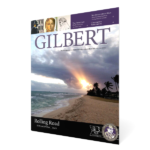Daily News Volume 1, 1901-1902
Back in those dark days of my former life when I was a lobbyist, there were occasions of light that suggested something much better waited for me. One of those was the extra day I spent in Washington DC after nearly a week of meetings with senators, congressmen, and bureaucrats. That extra day found me in the bowels of the Library of Congress working a microfilm machine from the time the library opened to the minute it closed. I was printing copies of essays by G.K. Chesterton from the Daily News. It was like finding lost Scripture. Almost no one had seen these essays for nearly a century.
After another trip to Washington DC and still another to the University of Chicago, I eventually copied all I could find, some 600 essays. I then put a troop of typists together to get them all typed up. The plan was to get them into book form, just as all the Chesterton essays from the Illustrated London News were reprinted by Ignatius Press as part of the Collected Works project. As wonderful as the ILN material is, there is something even fresher and livelier and more inventive in the Daily News essays as Chesterton spreads his wings and learns to fly as a young London journalist at the dawn of the 20th century. But the Ignatius project continued to move oh, so slowly, and the collection of all the ILN essays waited for completion nearly 20 years after the first volume had come out. My hopes of getting the Daily News essays into print was further dampened by the fact that there are no scholars around who were even aware of them must less interested in taking on the task of editing them.
Then, like a beam of light bursting through the clouds, along comes Julia Stapleton, a professor from the University of Durham, in England. Her special interest happens to be early 20th century political thought, and she has already written a book on Chesterton. She wants to take on the Daily News project, editing and annotating and preparing the essays for publication. I am only too happy to assist her. She is naturally thrilled that I already have them in electronic form.
But not all of them. Julia went to work and found at least 20 essays (and some letters to the editor) that I had missed, including early unsigned ones. One of the most enjoyable parts of my very minor collaboration with her was to offer my opinion on the early unsigned articles. Were they or weren’t they by Chesterton? I had pegged the earliest one as being an anonymous review of a book about Swinburne, February 12, 1901, but she found not one but two earlier pieces, the earliest being a review of a book on the history of Chinese literature from January 16, 1901. There is a certain Norwegian bibliographer who claims there are earlier ones. Ah, but where are they? There is no question that there is early unsigned Chesterton journalism out there, if not in the Daily News, then in other papers and publications. All we need is all the time in the world to find them. And something to drink while we’re looking.
Unfortunately, Ignatius did not jump on the opportunity to publish the marvelous collection that Julia had edited. Perhaps even more unfortunately, Pickering and Chatto did. The result is a beautiful set of eight hard bound volumes. Nothing wrong with that. The unfortunate bit is the price. Over one thousand dollars. Some day, we hope, it will come out in an affordable edition. In the meantime, it will only be found in an occasional library of an occasional institution. It may as well still be on microfilm in the Library of Congress.
The first volume is probably the most fascinating and delightful of all of them. Chesterton bursts on the literary scene with confidence and, in Julia Stapleton’s words, “creative vitality.” He begins as a book reviewer taking on texts by both the famous and the obscure, and then expanding to literature and art in general. He writes on Kipling, Omar Khayaam, Stevenson, Yeats, Shakespeare (and sadly, Francis Bacon), Schopenhauer, George MacDonald, Rostand, Ruskin, Carlyle, Tennyson, Walter Scott, Browning, Byron, the Brontës, Cervantes, Tolstoy, Shelley, Dickens, Walt Whitman, and someone named Shaw. He comes to the rescue of form against fashion, of delight against despair, of robust verse against “the poetry of emotional collapse,” and bold faith against snide doubt. He has chosen to cross swords with the modern world and its “appalling absence of joy.” His politics spill over into his art as politics always do. He defends democracy and the common man against the snobs and aristocrats in the studio and in the street. “Democracy,” he says, “cannot be conducted as a tame, mechanical, utilitarian thing, the final solution of social problems. If it is to be conducted at all, it must be conducted as a religion was, as a heroic enterprise, as an immortal battle, and an everlasting crisis.”
He defends the natural ideal of patriotism against the stilted and artificial ideals of humanitarianism.
It seems to me one of the oldest and idlest mistakes to suppose that we come nearer to men by ignoring those very partialities which make life tolerable to them. To love humanity while despising patriotism is to love the bodies of the peoples and to despise their souls. If we are broad enough to share all the dominant traits of humanity we must primarily share its narrowness. A man is far more closely linked with the life of nature by loving his own children than by attempting to yearn over the youthful boa constrictor or dandle the infant rhinoceros.
He says that we would not complain of materialism “if common-sense were only common.” It is an observation he would make of many more modern philosophies over the next three plus decades. But here sound the clear notes of his chorus for the first time.

